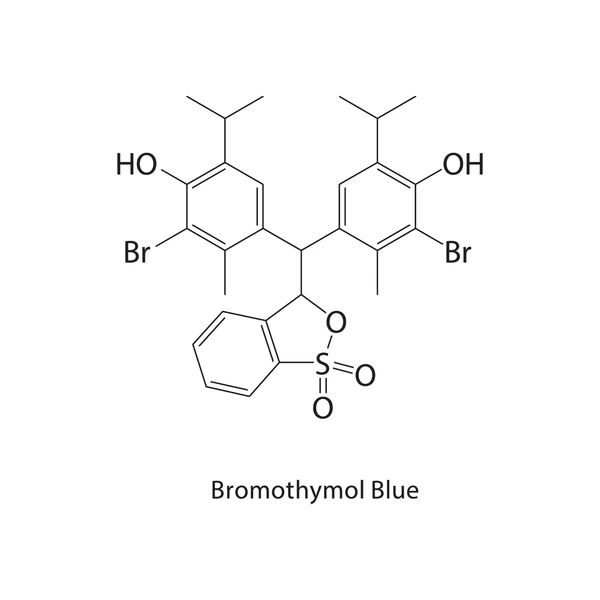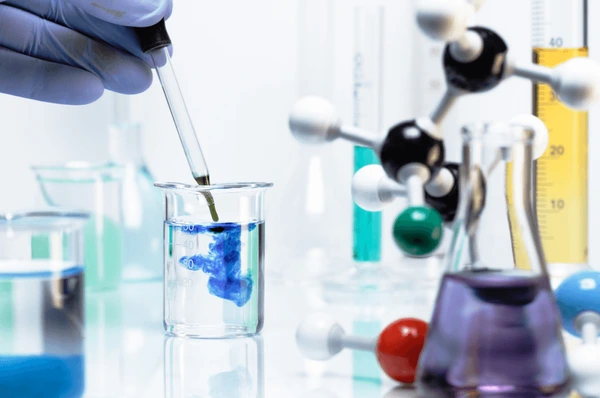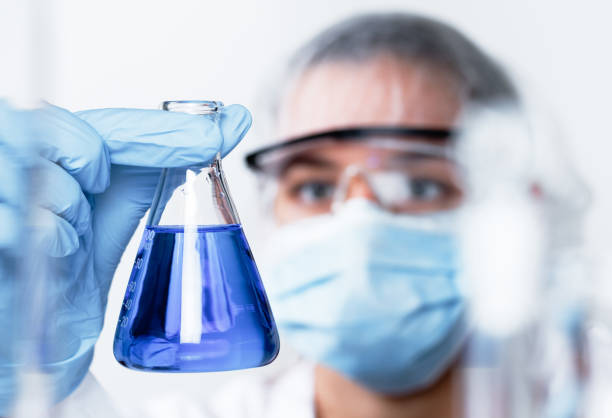Bromothymol blue is a vital chemical compound widely used in laboratories, classrooms, aquariums, and scientific experiments for its ability to indicate pH changes. As a trusted pH indicator, bromothymol blue (BTB) offers a quick and visual representation of acidic or basic conditions, making it a cornerstone in analytical chemistry and environmental studies.
Introduction to Bromothymol Blue
Bromothymol blue, also known as BTB, is a pH indicator dye derived from thymol. It belongs to the family of triphenylmethane dyes and is most recognized for its color-changing properties in different pH environments. The molecular formula is C₂₇H₂₈Br₂O₅S, and it appears as a blue or green solid in its pure form.
When dissolved in water or ethanol, bromothymol blue solution changes color depending on the hydrogen ion concentration of the surrounding medium:
- Yellow in acidic solutions (pH < 6.0)
- Green at neutral pH (around 7.0)
- Blue in basic solutions (pH > 7.6)
Chemical Properties of Bromothymol Blue Indicator
| Property | Value |
|---|---|
| Chemical Formula | C₂₇H₂₈Br₂O₅S |
| Molar Mass | 624.38 g/mol |
| Appearance | Greenish-blue crystalline powder |
| Solubility | Soluble in water and ethanol |
| pH Range | 6.0 (yellow) to 7.6 (blue) |
The bromothymol blue pKa value is approximately 7.1, aligning perfectly with neutral pH detection.
How Bromothymol Blue Indicator Works as a pH Indicator
Bromothymol blue functions through acid-base equilibrium. In acidic solutions, it remains in its protonated form, exhibiting a yellow color. As the pH increases, the hydrogen ions dissociate, shifting the equilibrium and resulting in a blue color.
Color Transition:
- pH < 6.0 → BTB is yellow
- pH 6.0 – 7.6 → BTB shows green (transition zone)
- pH > 7.6 → BTB is blue
This sharp transition range makes bromothymol blue an excellent indicator for detecting neutrality and slight shifts toward acidity or alkalinity, commonly used in titration experiments and respiration studies.
Uses of Bromothymol Blue Indicator
1. Laboratory Experiments

Bromothymol blue in titrations is a textbook example of its application. It helps scientists identify the endpoint of acid-base reactions, particularly where the pH of the solution approaches neutrality.
2. Educational Demonstrations
In classrooms, bromothymol blue is used to visually demonstrate pH changes. A popular activity is to show how exhaled carbon dioxide turns BTB solution yellow due to the formation of carbonic acid.
3. Measuring Carbon Dioxide
In biological studies, BTB serves as a tool to observe cellular respiration. When carbon dioxide is released during respiration, it acidifies the medium, turning bromothymol blue from blue to yellow.
4. Aquatic pH Monitoring
BTB is used in aquarium testing kits and ponds to ensure the water’s pH remains suitable for aquatic life. The quick color change provides an easy and immediate assessment.
5. Photosynthesis Experiments
In plant science, BTB reveals photosynthesis activity. When aquatic plants photosynthesize, they remove CO₂ from the solution, causing a shift toward basicity, and the indicator changes from yellow back to blue.
How to Prepare Bromothymol Blue Indicator
Materials Needed:
- Bromothymol blue powder
- Ethanol or distilled water
- Beaker
- Measuring cylinder
Preparation Steps:
- Dissolve 0.1 grams of bromothymol blue in 100 mL of ethanol.
- Add distilled water until the final volume reaches 500 mL.
- Store in a tightly sealed, dark container to avoid degradation.
Note: For best results, always use a fresh solution and keep it away from light.
Safety and Handling Guidelines

While bromothymol blue is considered relatively safe, it’s still a chemical compound and should be handled with care.
- Avoid ingestion and inhalation.
- Use gloves and safety goggles.
- Store in a cool, dry place, away from sunlight.
- Although bromothymol blue is generally regarded as relatively safe, it is still a chemical substance and should be handled with caution.
Always follow MSDS (Material Safety Data Sheet) guidelines for safe handling and disposal.
Comparison with Other Indicators
| Indicator | pH Range | Color Change | Best Used For |
|---|---|---|---|
| Bromothymol Blue | 6.0 – 7.6 | Yellow → Green → Blue | Neutrality detection |
| Phenolphthalein | 8.2 – 10.0 | Colorless → Pink | Titrations with strong bases |
| Methyl Orange | 3.1 – 4.4 | Red → Yellow | Strong acid vs weak base titrations |
| Litmus | 4.5 – 8.3 | Red → Blue | General acid-base indicator |
This comparison emphasizes bromothymol blue’s niche as an indicator for experiments close to neutral pH, especially in biological contexts.
Bromothymol Blue Indicator in Research and Innovation
Modern research has begun to explore the integration of bromothymol blue in smart sensors, microfluidic devices, and digital pH detectors. The dye’s vivid and reversible color change, combined with its chemical stability, makes it an ideal component for biosensors and environmental monitoring tools.
Storage and Shelf Life of Bromothymol Blue Indicator

To maintain accuracy, store bromothymol blue in amber bottles that are protected from light, heat, and air. The powder has a long shelf life if kept dry; however, once dissolved, the solution should be used within 1 to 2 weeks for optimal results.
Conclusion
Bromothymol blue is more than just a colorful chemical. It is a versatile, sensitive, and indispensable tool in analytical chemistry, biology, environmental science, and education. Whether you’re conducting a simple classroom demo or measuring real-time CO₂ levels in aquatic systems, bromothymol blue delivers reliable, vivid, and immediate feedback.
What is Bromothymol Blue?
Bromothymol blue is a vital chemical compound widely used in laboratories, classrooms, aquariums, and scientific experiments for its ability to indicate pH changes. As a trusted pH indicator, bromothymol blue (BTB) offers a quick and visual representation of acidic or basic conditions, making it a cornerstone in analytical chemistry and environmental studies.
What is Bromothymol Indicator?
Bromothymol Indicator, also known as BTB, is a pH indicator dye derived from thymol. It belongs to the family of triphenylmethane dyes and is most recognized for its color-changing properties in different pH environments. The molecular formula is C₂₇H₂₈Br₂O₅S, and it appears as a blue or green solid in its pure form.
When dissolved in water or ethanol, bromothymol blue solution changes color depending on the hydrogen ion concentration of the surrounding medium:
Yellow in acidic solutions (pH < 6.0)
Green at neutral pH (around 7.0)
Blue in basic solutions (pH > 7.6)
Chemical Properties of Bromothymol Indicator
Property
Value
Chemical Formula
C₂₇H₂₈Br₂O₅S
Molar Mass
624.38 g/mol
Appearance
Greenish-blue crystalline powder
Solubility
Soluble in water and ethanol
pH Range
6.0 (yellow) to 7.6 (blue)
The bromothymol blue pKa value is approximately 7.1, aligning perfectly with neutral pH detection.
How Bromothymol Works as a pH Indicator
Bromothymol blue functions through acid-base equilibrium. In acidic solutions, it remains in its protonated form, exhibiting a yellow color. As the pH increases, the hydrogen ions dissociate, shifting the equilibrium and resulting in a blue color.
Color Transition: Bromothymol Indicator
pH < 6.0 → BTB is yellow
pH 6.0 – 7.6 → BTB shows green (transition zone)
pH > 7.6 → BTB is blue
This sharp transition range makes bromothymol blue an excellent indicator for detecting neutrality and slight shifts toward acidity or alkalinity, commonly used in titration experiments and respiration studies.
Uses of Bromothymol Indicator
1. Laboratory Experiments
Bromothymol blue in titrations is a textbook example of its application. It helps scientists identify the endpoint of acid-base reactions, particularly where the pH of the solution approaches neutrality.
2. Educational Demonstrations
In classrooms, bromothymol blue is used to visually demonstrate pH changes. A popular activity is to show how exhaled carbon dioxide turns BTB solution yellow due to the formation of carbonic acid.
3. Measuring Carbon Dioxide
In biological studies, BTB serves as a tool to observe cellular respiration. When carbon dioxide is released during respiration, it acidifies the medium, turning bromothymol blue from blue to yellow.
4. Aquatic pH Monitoring
BTB is used in aquarium testing kits and ponds to ensure the water’s pH remains suitable for aquatic life. The quick color change provides an easy and immediate assessment.
5. Photosynthesis Experiments
In plant science, BTB reveals photosynthesis activity. When aquatic plants photosynthesize, they remove CO₂ from the solution, causing a shift toward basicity, and the indicator changes from yellow back to blue.
How to Prepare Bromothymol Solution
Materials Needed:
Bromothymol blue powder
Ethanol or distilled water
Beaker
Measuring cylinder
Preparation Steps: Bromothymol Indicator
Dissolve 0.1 grams of bromothymol in 100 mL of ethanol.
Add distilled water until the final volume reaches 500 mL.
Store in a tightly sealed, dark container to avoid degradation.
Note: For best results, always use a fresh solution and keep it away from light.
Safety and Handling Guidelines
While bromothymol blue is considered relatively safe, it’s still a chemical compound and should be handled with care.
Avoid ingestion and inhalation.
Use gloves and safety goggles.
Store in a cool, dry place, away from sunlight.
Although bromothymol blue is generally regarded as relatively safe, it is still a chemical substance and should be handled with caution.
Always follow MSDS (Material Safety Data Sheet) guidelines for safe handling and disposal.
Comparison with Other Indicators
Indicator
pH Range
Color Change
Best Used For
Bromothymol Blue
6.0 – 7.6
Yellow → Green → Blue
Neutrality detection
Phenolphthalein
8.2 – 10.0
Colorless → Pink
Titrations with strong bases
Methyl Orange
3.1 – 4.4
Red → Yellow
Strong acid vs weak base titrations
Litmus
4.5 – 8.3
Red → Blue
General acid-base indicator
This comparison emphasizes bromothymol as an indicator for experiments close to neutral pH, especially in biological contexts.
Bromothymol Blue in Research and Innovation
Modern research has begun to explore the integration of bromothymol blue in smart sensors, microfluidic devices, and digital pH detectors. The dye’s vivid and reversible color change, combined with its chemical stability, makes it an ideal component for biosensors and environmental monitoring tools.
Storage and Shelf Life
To maintain accuracy, store bromothymol blue in amber bottles that are protected from light, heat, and air. The powder has a long shelf life if kept dry; however, once dissolved, the solution should be used within 1 to 2 weeks for optimal results.
Conclusion
Bromothymol is more than just a colorful chemical. It is a versatile, sensitive, and indispensable tool in analytical chemistry, biology, environmental science, and education. Whether you’re conducting a simple classroom demo or measuring real-time CO₂ levels in aquatic systems, bromothymol blue delivers reliable, vivid, and immediate feedback.
How to Prepare Bromothymol Blue Indicator.
Bromothymol Blue Indicator is a vital chemical compound widely used in laboratories, classrooms, aquariums, and scientific experiments for its ability to indicate pH changes. As a trusted pH indicator, bromothymol blue (BTB) offers a quick and visual representation of acidic or basic conditions, making it a cornerstone in analytical chemistry and environmental studies.
What is Bromothymol?
Bromothymol Indicator, also known as BTB, is a pH indicator dye derived from thymol. It belongs to the family of triphenylmethane dyes and is most recognized for its color-changing properties in different pH environments. The molecular formula is C₂₇H₂₈Br₂O₅S, and it appears as a blue or green solid in its pure form.
When dissolved in water or ethanol, bromothymol solution changes color depending on the hydrogen ion concentration of the surrounding medium:
Yellow in acidic solutions (pH < 6.0)
Green at neutral pH (around 7.0)
Blue in basic solutions (pH > 7.6)
Chemical Properties of Bromothymol Blue
Property
Value
Chemical Formula
C₂₇H₂₈Br₂O₅S
Molar Mass
624.38 g/mol
Appearance
Greenish-blue crystalline powder
Solubility
Soluble in water and ethanol
pH Range
6.0 (yellow) to 7.6 (blue)
The bromothymol blue pKa value is approximately 7.1, aligning perfectly with neutral pH detection.
How Bromothymol Works as a pH Indicator
Bromothymol blue functions through acid-base equilibrium. In acidic solutions, it remains in its protonated form, exhibiting a yellow color. As the pH increases, the hydrogen ions dissociate, shifting the equilibrium and resulting in a blue color.
Color Transition: Bromothymol Indicator
pH < 6.0 → BTB is yellow
pH 6.0 – 7.6 → BTB shows green (transition zone)
pH > 7.6 → BTB is blue
This sharp transition range makes bromothymol an excellent indicator for detecting neutrality and slight shifts toward acidity or alkalinity, commonly used in titration experiments and respiration studies.
Uses of Bromothymol Indicator
1. Laboratory Experiments
Bromothymol in titrations is a textbook example of its application. It helps scientists identify the endpoint of acid-base reactions, particularly where the pH of the solution approaches neutrality.
2. Educational Demonstrations
In classrooms, bromothymol blue is used to visually demonstrate pH changes. A popular activity is to show how exhaled carbon dioxide turns BTB solution yellow due to the formation of carbonic acid.
3. Measuring Carbon Dioxide
In biological studies, BTB serves as a tool to observe cellular respiration. When carbon dioxide is released during respiration, it acidifies the medium, turning bromothymol blue from blue to yellow.
4. Aquatic pH Monitoring
BTB is used in aquarium testing kits and ponds to ensure the water’s pH remains suitable for aquatic life. The quick color change provides an easy and immediate assessment.
5. Photosynthesis Experiments
In plant science, BTB reveals photosynthesis activity. When aquatic plants photosynthesize, they remove CO₂ from the solution, causing a shift toward basicity, and the indicator changes from yellow back to blue.
How to Prepare Bromothymol Solution
Materials Needed: Bromothymol Indicator
Bromothymol blue powder
Ethanol or distilled water
Beaker
Measuring cylinder
Preparation Steps: Bromothymol Indicator
Dissolve 0.1 grams of bromothymol blue in 100 mL of ethanol.
Add distilled water until the final volume reaches 500 mL.
Store in a tightly sealed, dark container to avoid degradation.
Note: For best results, always use a fresh solution and keep it away from light.
Safety and Handling Guidelines of Bromothymol Indicator
While bromothymol blue is considered relatively safe, it’s still a chemical compound and should be handled with care.
Avoid ingestion and inhalation.
Use gloves and safety goggles.
Store in a cool, dry place, away from sunlight.
Although bromothymol blue is generally regarded as relatively safe, it is still a chemical substance and should be handled with caution.
Always follow MSDS (Material Safety Data Sheet) guidelines for safe handling and disposal.
Comparison with Other Indicators
Indicator
pH Range
Color Change
Best Used For
Bromothymol Blue
6.0 – 7.6
Yellow → Green → Blue
Neutrality detection
Phenolphthalein
8.2 – 10.0
Colorless → Pink
Titrations with strong bases
Methyl Orange
3.1 – 4.4
Red → Yellow
Strong acid vs weak base titrations
Litmus
4.5 – 8.3
Red → Blue
General acid-base indicator
This comparison emphasizes bromothymol blue’s niche as an indicator for experiments close to neutral pH, especially in biological contexts.
Bromothymol Indicator in Research and Innovation
Modern research has begun to explore the integration of bromothymol in smart sensors, microfluidic devices, and digital pH detectors. The dye’s vivid and reversible color change, combined with its chemical stability, makes it an ideal component for biosensors and environmental monitoring tools.
Storage and Shelf Life of Bromothymol Indicator
To maintain accuracy, store bromothymol blue in amber bottles that are protected from light, heat, and air. The powder has a long shelf life if kept dry; however, once dissolved, the solution should be used within 1 to 2 weeks for optimal results.
Conclusion
Bromothymol is more than just a colorful chemical. It is a versatile, sensitive, and indispensable tool in analytical chemistry, biology, environmental science, and education. Whether you’re conducting a simple classroom demo or measuring real-time CO₂ levels in aquatic systems, bromothymol blue delivers reliable, vivid, and immediate feedback.
Is bromothymol blue indicator toxic?
Can bromothymol indicator be used at home?
Does temperature affect its accuracy?
What color does bromothymol blue indicator turn in vinegar?
What are the uses of bromothymol blue indicator?
1. Laboratory Experiments
Bromothymol in titrations is a textbook example of its application. It helps scientists identify the endpoint of acid-base reactions, particularly where the pH of the solution approaches neutrality.
2. Educational Demonstrations
In classrooms, bromothymol blue is used to visually demonstrate pH changes. A popular activity is to show how exhaled carbon dioxide turns BTB solution yellow due to the formation of carbonic acid.
3. Measuring Carbon Dioxide
In biological studies, BTB serves as a tool to observe cellular respiration. When carbon dioxide is released during respiration, it acidifies the medium, turning bromothymol blue from blue to yellow.
4. Aquatic pH Monitoring
BTB is used in aquarium testing kits and ponds to ensure the water’s pH remains suitable for aquatic life. The quick color change provides an easy and immediate assessment.
5. Photosynthesis Experiments
In plant science, BTB reveals photosynthesis activity. When aquatic plants photosynthesize, they remove CO₂ from the solution, causing a shift toward basicity, and the indicator changes from yellow back to blue.
